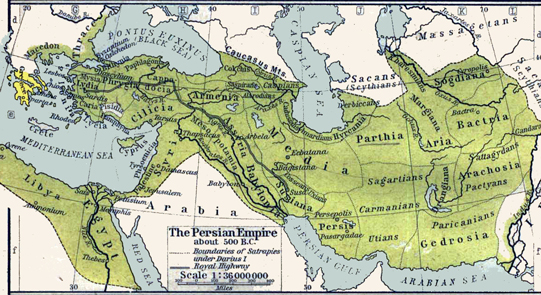Battles don't come out of the blue. The tension between Greece and Persia had been building for a while. Here we look at the background to Marathon and the rest of the Persian Wars.
The map shows Greece and the Aegean Sea at the time of Marathon. Greece was made up of lots of city states - small countries with one big city as their capital. Athens, Sparta, Thebes, and Eretria were all city states. A hoplite would fight for his own city state - often against other Greek cities.
On the east side of the Aegean was an area called Ionia. Here there were more Greek cities, sharing the same language and culture as other Greeks. On the map you can see Ephesus and Miletus, two of the most important cities of Ionia. About 60 years before Marathon, all this area was taken over by the Persian Empire, when they conquered Asia Minor (now called Turkey). They ruled Asia Minor from their capital at Sardis.
Revolution!
In 499BC, the ruler of Miletus, Aristagoras, decided he'd had enough of being bossed about by the Persians. But he couldn't just boot them out - they were far too powerful. So he went to some Greek cities to ask for help. The Spartan king, Kleomenes, asked how far it was to the Persian capital, Susa. Aristagoras said 3 months march. Kleomenes laughed at him and sent him away. There was no way he was going to send his Spartan warriors that far from home. (You can see Susa in the middle of the map, in tiny letters; Greece is in the yellow.).
So Aristagoras went to Athens, then Eretria. Both said they would help. Athens sent 20 ships - about 1,000 men - and Eretria 5 ships. They sailed to Ephesus, and marched over the hill to Sardis. Here they attacked, burning the city, including the temple of the local goddess Cybele, killing many of the people.
Revenge!
According to Herodotus, after the attack on Sardis, Darius the king of Persia was angry. He shot an arrow into the sky and asked Zeus for revenge on the Athenians. He also told his servant to say three times before each meal, 'master, remember the Athenians'.
This is probably a myth that Herodotus put in to spice up his history. Persians didn't even worship Zeus - their king of the Gods was called Ahura Mazda. However Darius probably was annoyed and had been thinking of conquering Greece anyway.
First he had to put down the revolt in Ionia. And before that he had to get his subjects to build lots and lots of ships. In 494BC the Persian fleet and the Ionian fleet faced each other at the battle of Lade, near Miletus. The Ionians might have done pretty well, but they were betrayed by the men of Samos, and then others, who defected - went over to the Persians.
The Capture of Miletus
After that the Persians destroyed the great city of Miletus. They burned the buildings, killed most of the men, and enslaved the women and children. A year or so later, the Athenians saw a play called The Capture of Miletus, which told this sad tale. They were so upset, bursting into tears at the fate of their fellow Greeks, that they fined the playwright 2,000 drachmas and banned the play from any future performances. Clearly everyone was worried that exactly the same thing was going to happen to Athens.
The Persians Approach
After Lade the Persians began attacking and taking back the rest of Ionia - Chios, Lesbos, Tenedos, and so on. In 492BC Darius sent an enormous army under general Mardonios to invade Greece. They came around from the North East, attacking Thrace then Macedonia, and conquering both (see the map at the top). Imagine how the Athenians must have felt! Unfortunately for Mardonios his army suffered many losses in battle, and his fleet was sunk by a terrible storm off Mount Athos, so he gave up before attacking Greece. The Greeks must have thought Zeus was protecting them.


 King
Darius (right, with bow)
King
Darius (right, with bow)
The Heralds
The next year, 491BC, Darius decided to try to take over Greece without fighting. He sent heralds - ambassadors - to each city state in Greece, asking for earth and water. This was a symbol for submission - giving over your land and sea to Persia.
At Sparta, King Kleomenes pushed the heralds into a well, saying 'get your earth and water there.' (This scene is in the film 300, except they have Leonidas doing it, even though he wasn't king yet!)
At Athens, general Miltiades persuaded the Athenian citizens to vote for executing the heralds. Like the Spartans, they pushed them into a hole on the ground - a chasm called the barathron. Eretria also refused earth and water, as did a few other cities.
War was now unavoidable. And it came next year - 490BC.

Scene from 300 - King Leonidas kicks the Persian herald into a well.
Two mistakes: it was Kleomenes, not Leonidas; and the herald was Persian, not African.
That's Hollywood for you.